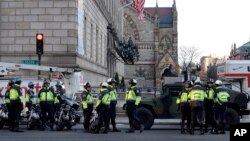Investigators in Boston have started the task of poring over extensive images from the city's vast collection of security cameras for clues about who planted deadly bombs near the finish line of Monday's Boston Marathon.
Boston Police Commissioner Ed Davis told a news conference Tuesday there were numerous cameras positioned in the immediate area near where the two explosions killed three people and wounded 176 others.
"It's our intention to go through every frame of every video that we have to determine exactly who was in the area. This was probably one of the most well-photographed areas in the country yesterday," said Davis.
The head of the Boston office of the Federal Bureau of Investigation, Rick DesLauriers, said investigators already have looked at a large number of photos taken by witnesses near the explosions, and appealed for any others the public might have that would provide clues about the twin blasts.
"We are processing a lot of photographic, digital photographic evidence right now, as several speakers have said today, including the governor. We encourage the continued submission of any photographic evidence that could lead to value," said DesLauriers.
In the wake of the 2001 terrorist attacks in the U.S., numerous American cities, including Boston, installed security cameras at key public vantage points in hopes of preventing another attack and to provide evidence about other crimes.
Security cameras are installed in Boston's bustling shopping districts, such as the city streets where the bombs exploded, and along major thoroughfares.
Boston has nearly 500 cameras on its subway system, and more on city buses. Cameras on bridges and at toll booths could trace anyone driving through those vantage points.
The cameras are linked to the city's Real Time Crime Center, where police can monitor activity across a large swath of the city.
The system links Boston and eight nearby communities so authorities can share images and possibly track the movements of suspects.
Boston Police Commissioner Ed Davis told a news conference Tuesday there were numerous cameras positioned in the immediate area near where the two explosions killed three people and wounded 176 others.
"It's our intention to go through every frame of every video that we have to determine exactly who was in the area. This was probably one of the most well-photographed areas in the country yesterday," said Davis.
The head of the Boston office of the Federal Bureau of Investigation, Rick DesLauriers, said investigators already have looked at a large number of photos taken by witnesses near the explosions, and appealed for any others the public might have that would provide clues about the twin blasts.
"We are processing a lot of photographic, digital photographic evidence right now, as several speakers have said today, including the governor. We encourage the continued submission of any photographic evidence that could lead to value," said DesLauriers.
In the wake of the 2001 terrorist attacks in the U.S., numerous American cities, including Boston, installed security cameras at key public vantage points in hopes of preventing another attack and to provide evidence about other crimes.
Security cameras are installed in Boston's bustling shopping districts, such as the city streets where the bombs exploded, and along major thoroughfares.
Boston has nearly 500 cameras on its subway system, and more on city buses. Cameras on bridges and at toll booths could trace anyone driving through those vantage points.
The cameras are linked to the city's Real Time Crime Center, where police can monitor activity across a large swath of the city.
The system links Boston and eight nearby communities so authorities can share images and possibly track the movements of suspects.








